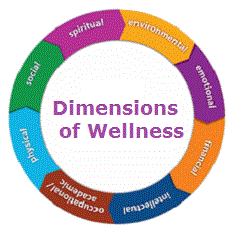Wellness Checklist – Wellness is a state of one’s well-being and is achieved through self-directed, focused and conscious effort along various dimensions including one’s Health (Physical), Financial, Emotional, Environmental, Spiritual, Social, Occupational (Job) and Intellectual state of being. Success achieved in some of these areas may constitute for the feeling of happiness and pride but the effect is often short-lived. To achieve long-lasting wellness one really needs to balance across most or all of the wellness dimensions listed here.
Wellness Chart

Health or Physical – recognizes the need for healthy diet, wellness, exercise, good sleep and discourages use of tobacco, alcohol and drugs
Financial – encourages savings, management of debt and financial literacy
Environmental – involves feeling safe in one’s surrounding including home and work places
Occupational – recognizes success in daily professional activities including feelings of doing something meaningful and purposeful
Emotional or Mental – involves capacity to express feelings and cope with difficult situations
Intellectual – recognizes the pursuit of knowledge and creativity while also emphasizing the need to share the learning with others
Social – encourages strong links with one’s community, communication and socializing between individuals
Spiritual – recognizes one’s beliefs and values including sense of purpose and inner balance
Dimensions of Wellness
The 8 dimensions of wellness are presented in the cycle symbolizing the interconnection between the various dimensions.

Health Wellness Checklist
The below checklist focuses on the Health or Physical dimension and includes the following 3 main categories: Nutrient, Exercise and Habits. Nutrient includes eating variety of foods, primarily plant based, with low sodium, low calorie and low sugar content. Exercise includes strength building, aerobic and flexible workouts. Habits include good sleep, no smoking and low alcohol and caffeine consumption.

Financial Wellness
The financial wellness checklist includes the key attributes of the financial well-being including exploring current attitudes about money, establishing financial goals, developing a budget, identifying saving strategies (from short to long term), utilizing insurance, leaving a legacy and living with influence (e.g. helping others, taking time for self).


